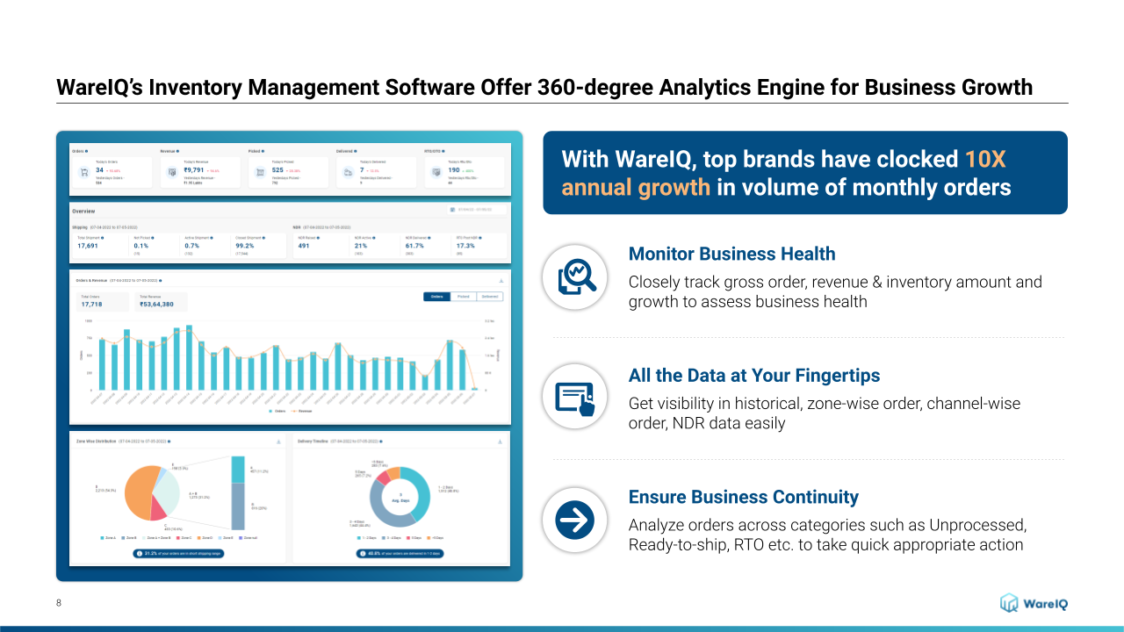Definition, Importance and 5 Step-By-Step Processes of Stock Reconciliation In 2025

It is sometimes likely that the inventory counts in your records and the actual amount of products on your shelves don’t always match.
This mismatch, while frequent, can have a significant impact on your organization. To avoid stockouts and guarantee that your consumers get what they need when they need it, you need to know how many goods you have in stock and how much stock you need for the future.
You can employ stock reconciliation to determine the stock discrepancy between what’s in your records and your warehouse and then make modifications to bring your figures into line. This is a critical step in ensuring that inventory is ordered as needed and that things are readily available for sale. In this blog, we will take a detailed look at the meaning of stock reconciliation, its importance, the processes involved in doing and the challenges faced while doing it.
- What is Stock Reconciliation?
- Importance of Inventory Reconciliation
- 5 Step-by-Step Processes Involved in Stock Reconciliation
- Step 1: Make a Note of Your Actual Inventory Count
- Step 2: Perform a Side-by-Side Comparison of Physical Inventory and Inventory Records
- Step 3: Analyse Purchases and Sales of Inventory Since the Previous Reconciliation
- Step 4: Remove Any Disparities That May Exist
- Step 5: Repeat the Process of Reconciling Inventory Consistently
- Challenges to Stock Reconciliation
- Conclusion
- Stock Reconciliation: FAQs
What is Stock Reconciliation?
Stock reconciliation refers to matching inventory data to real-world inventory items in is stored in your business’s warehouse or fulfillment center. To do so, prepare a stock reconciliation report that accurately displays your current inventory and includes or disposes of stock items from the database.
- This is an essential step since it aids in the reduction of stock disparities and helps in understanding why they exist in the first place.
- Inventory reconciliation should be done regularly to guarantee that all inventory is accounted for.
- An inventory reconciliation report compares the business’s written inventory records to the physical goods in storage.
- If this data doesn’t match, the report can assist in determining the cause of the issue.
- If you cannot find the cause of the difference, you should update the written inventory records to reflect the actual inventory level and the necessary accounting entries that need to be made.
WareIQ, an eCommerce fulfillment company, empowers online brands with a superior-tech platform to compete with Amazon like service levels by bringing their average delivery timelines from 5-10 days to 1-2 days.
Importance of Inventory Reconciliation
There can be dire consequences for the business when the records do not match the physical inventory. Even with the best inventory management and control technology, inventory shrinkage to some extent is inevitable. There’s no denying that human error and blunders are to blame for part of this shrinkage.
The quality of the data recorded and handled in the inventory control system determines the accuracy of the information. Inventory reconciliation allows you to keep track of shrinkage and search for symptoms of greater problems such as dwindling customer demand or employee theft.
Performing an inventory reconciliation helps your business to keep inventory organized and is important for the following reasons:
- It ensures your written records for inventory figures are accurate by aligning these records to those obtained via a physical check.
- It ensures that all kinds of stock are separately recorded and included in the written records.
- It helps in tracking your inventory more seamlessly to prevent incidents such as theft and manual errors.
- It provides a starting point for investigating the differences between inventory-in-hand and inventory purchased from suppliers by identifying the source of these differences through the use of item characteristics.
- Businesses find it helpful in judging their stock-loss percentage compared to prevalent industry rates.
5 Step-by-Step Processes Involved in Stock Reconciliation
Inventory reconciliation is more complicated than just changing the numbers in your books to reflect the amount of inventory in your warehouse. There are a variety of explanations for the discrepancy in the figures and you must figure out what’s going on, which can be done in the following ways:
Step 1: Make a Note of Your Actual Inventory Count
- The number of items a business has on hand is known as physical inventory. The number of actual objects on your shelf is the one definitive thing that cannot be disputed.
- Businesses should arrange a time for qualified management to do physical inventory counts and double-check their data.
- Check your physical inventory count before browsing through your records. This may be accomplished by devoting a day or two to calculating the number of items in your inventory.
- This is crucial since it becomes conceivable whether the inventory was originally miscounted or recorded incorrectly. Furthermore, if you’re distributing goods between different sites, the physical inventory count may be lower than the figures in your books.
Step 2: Perform a Side-by-Side Comparison of Physical Inventory and Inventory Records
- Compare your real inventory numbers to existing inventory records once you’ve recorded them.
- You should double-check that these numbers match the physical location of each item on your shelves.
- You’ll find out whether there are any inconsistencies during this procedure.
- Several factors might cause a discrepancy between your physical inventory count and your inventory management count, some of which are listed below:
- Paperwork that has gone missing
- Human errors
- Mathematical miscalculations
- Unlisted items
- Scrap items
- Fraud by suppliers
- Items that belong to a consumer or a supplier
- Items that have expired and thrown away
You have to look into all options to determine the root of the problem, note what’s causing the disparity, and make the necessary changes to your processes and records to prevent the same problem from occurring again.
Step 3: Analyse Purchases and Sales of Inventory Since the Previous Reconciliation
- If you’ve done a stock reconciliation before, go back and check if any inconsistencies were discovered that might explain the discrepancy in figures during the current reconciliation.
- Compare your inventory reconciliation findings to previous ones. This can help in identifying trends and patterns, as well as the identification of areas that need more research.
- This is especially useful if any difficulties need to be addressed.
- Being aware of these problems and issues allows you to concentrate more attentively on those specific items, either averting future difficulties or supporting you in finding the cause of the issue.
Step 4: Remove Any Disparities That May Exist
- It’s up to you to decide how much shrinkage is acceptable in your company. It may be more time-consuming and costly to identify the reason for the loss rather than move on if the quantity or value of lost items is low enough to make an exception.
- If you need to identify the cause of it, start with your systems and personnel.
- If you’re using a contemporary inventory or retail management platform, you may simply update the products in your system to reconcile your records.
- While this causes an abrupt pause in your inventory statement, it does allow you to build a general ledger that will serve as the formal beginning point for future inventory.
- Steps in the recording process are frequently overlooked at the warehouse, on the store floor, and while updating it on the inventory management software used by the company.
- It is a good idea to interview the people who are in charge of each phase to see if there’s a reason for the disparity that can be rectified.
- If you can’t figure out what’s causing the disparity, consult with your team and identify each metric that could have caused it.
Step 5: Repeat the Process of Reconciling Inventory Consistently
- The advantages are lost if inventory reconciliation is not performed regularly.
- Regular stock reconciliation improves data accuracy and lowers inventory costs.
- Inventory reconciliation is only effective if you verify your stock regularly.
- As a result, you’ll get more accurate data over time and can reduce inventory loss, saving you money in the long run.
- Inventory reconciliations should be done regularly and the frequency should be based on what is best for your company. They can be time-consuming, so factor in any delays, sales halts, and labour expenses.
Challenges to Stock Reconciliation
Can be Time Consuming
Inventory reconciliation is time-consuming for every business, and no matter how frequently you count, you’ll have to tolerate certain amounts of unforeseen shrinkage due to factors such as damage, expiry, goods lost in transit, and many others. Frequent stock reconciliation can result in delays in delivering orders to customers and purchasing fresh stock that is needed to fulfill those orders.
Disruption in Operations
The place where you count your stock should be kept separate. This entails having access to a large warehouse or operational space to prevent the suspension of all inbound and outbound product movement is suspended for long periods of time. However, since it is already a struggle for many retailers to find enough storage space to fit in their existing inventory, this can be a challenge, as they often use third-party warehouses which don’t facilitate large sections that can be separated specifically for counting purposes.
Use of Incorrect Weightage Factors
The usage of incorrect weightage factors is a widespread issue that causes multiple monetary issues. When dealing internationally, for example, measuring a liquid in litres rather than in gallons or the other way around is often overlooked. This can cause confusion when noting down the dimensions of the product, especially if employees are not well versed in units of measurement and if the company deals in importing or exporting goods to other countries that use different metrics of measurement such as the US and Canada.
Difficult to do Without Advanced Software
If an order management system isn’t implemented, tracking replacements, refunds, and backorders make stock reconciliation problematic. In today’s world, using excel or similar basic spreadsheets introduces unneeded difficulties due to a lack of relevant features that are needed. Even though these solutions have worked quite effectively for a long time, a more comprehensive package is required in the current market.
They aren’t responsive enough to manage a wide distribution network and other peripheral aspects of the firm. They provide many opportunities for human mistakes and there is no base structure for spreadsheet reconciliation reports. Additionally, if a business stores inventory in multiple warehouses and sell products on different platforms, the only way to manage the movement of inventory accurately is to use inventory management software.
Manual Errors and Mismanagement of Inventory
Many of the common causes of the disparity between inventory records and physical inventory counts are due to manual errors while entering the data or mismanagement of resources which leads to inventory shrinkage, stockout situations, overstocking, wastage, and much more. These factors have an adverse effect on business operations and are difficult to mitigate unless a major management and staff overhaul is done if the problem occurs frequently because it can be difficult to ensure that every item is being counted and added correctly.
Conclusion
Managing inventory should be a key priority when a firm starts to grow. Taking the effort to reconcile inventory acts as a quality check for existing stock systems and alerts the management team to any data inconsistencies. Managers may use this information to determine which inventory control systems to adopt to improve functionality and expand their business. The amount of money spent on stock mismanagement is reduced when an effective stock control system is implemented.
While every organization’s ability to raise selling prices is restricted, focusing on the bottom line is a good strategy. Inventory reconciliation is a valuable tool for reducing losses and streamlining procedures. The key to reducing inventory shrinkage is for all departments to participate in simplifying and optimizing their particular tasks effectively.
You’ll need to do inventory reconciliations regularly to keep track of your inventory statistics. Inventory checks provide several advantages, including saving money, reducing theft, and ensuring that your consumers get the desired items. If you need assistance with inventory reconciliation, you can check out WareIQ.

WareIQ is one of India’s leading eCommerce fulfillment companies that utilize a strong technology infrastructure to provide a range of eCommerce fulfillment solutions, including inventory management and stock reconciliation. We give customers access to our advanced WMS that automatically tracks inventory across multiple fulfillment centers and selling channels, and automates multiple processes of inventory management to increase the speed and cost-effectiveness while reducing errors and issues.







